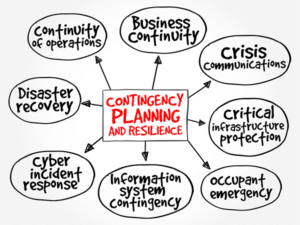
Part of running a modern business is planning for the quick recovery of your business’ computer processes in the event of an emergency. In the past, when the computers went down, they just went down.
According to this article, organizations create contingency plans, sometimes called a “Plan B,” to prepare for something bad that could affect the organization’s ability to function. Developing an effective contingency plan is essential for any organization.
Having a system in place to restore them immediately was unheard of for small and medium-sized businesses; and even for many large corporations. Professionals mainly used computers to run programs like Excel or Word. They managed files in certain ways and receptionists played Solitaire. However, as we all know, times have changed.
Now our global business culture is somewhat reliant on technology for many things like:
- Communication
- Marketing
- Customer relationship management
- Online and offline reputation management
- File storage
- Business processes
Because of this, it’s now crucial to back up your entire computer system and have protocols in place, so that your business can continue to run smoothly even when your systems are down.
Having a good contingency plan in place will ensure that business interruption, data loss, and productivity loss are minimal across all the devices that your company uses.
This could include your company:
- Desktops and laptops
- Mobile devices like smartphones and tablets
- Peripherals like printers and all-in-one fax machines
- Servers
- Websites
- Computer networks
- Mainframes
- Distributed systems
Depending on the size of your business and your standard operating procedures, some contingency plans might include:
Having to relocate your primary business and IT systems temporarily to an alternate site, using alternate equipment, or having your IT team reset some systems manually to get them working properly again
Here’s a Typical Contingency Plan Outline
1. State your goals – In the event of a power outage, drive failure or even an extreme condition like fire or water damage, what goals must your contingency plan meet for your business to remain efficient and operational?
2. Define the impact on your business – How much downtime can your business really handle? Some businesses can handle 7 days, while others can only handle 3 hours. What type of overall impact financially and professionally would an outage and downtime cause? What is the scope of varying degrees?
Though this may seem like redundant step, it’s not. Yes, “it would be bad,” is an answer that could apply to any negative situation. However, you might not realize that certain departments can handle much less downtime than you realized and some might not need much investment in contingency planning.
3. Once you’ve identified your goals and the potential impacts on your business, decide what preventive steps you can take to minimize problems; so you don’t have so much to fix during an outage – This could mean using certain types of backup, cloud servers located in other states and taking other simple measures that will mean certain parts of your business wouldn’t even need resetting or restoration.
4. Next identify your list of go-to recovery strategies – You should have a list of recovery strategies to implement immediately when something happens. You should have strategies appropriate for both small and extreme emergencies.
5. Next, take time to test your plan and train your staff – Every contingency plan is different, so just like a fire drill, your company staff and IT staff should understand how your plan will work.
6. Ensure that you’re taking the proper maintenance steps daily, weekly etc.
Should your IT team routinely check servers?
Does any software or equipment need biannual upgrading?
Do you have any new staff you need to train on how to properly backup their work or behave in an emergency situation?
Contact Us
We understand that contingency planning is just as much a part of modern businesses as smartphones and color printers. We understand how to make the restoration process simple for businesses, yet effective in the case of an emergency.






